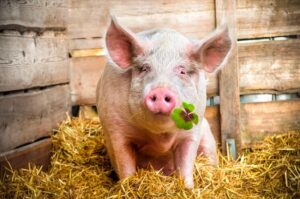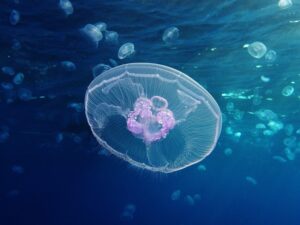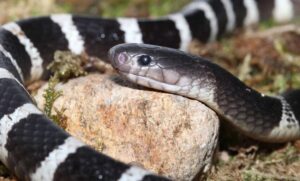Penguins are birds with funny-looking bodies that live mainly in the Southern Hemisphere, which has the lowest average annual temperatures on Earth. In this article, KnowAllAnimals and you will explore 10 fun facts about Penguins. Let’s go!
1. A Brief Look at Penguins
Penguins, also known as flightless birds, are a group of aquatic birds that cannot fly. They live almost exclusively in the Southern Hemisphere, with only one species, the Galapagos penguin, found north of the equator. Well-adapted to life in the water, penguins have a contrasting coat of dark and light patches and flippers for swimming. Most penguins eat krill, fish, squid, and other forms of marine life that they catch while swimming underwater. They spend about half their lives on land and the other half in the sea.
Although almost all penguin species are native to the Southern Hemisphere, they are not only found in cold climates, such as Antarctica. In fact, only a few species live far south. Some species are found in temperate zones, but one species, the Galapagos penguin, lives near the equator.
The largest living penguin species is the Emperor Penguin: on average, adults are about 1.1 m (3.6 ft) tall and weigh 35 kg (77 lbs). The smallest penguin species is the Little Blue Penguin, also known as the fairy penguin, which stands about 33 cm (13 inches) tall and weighs 1 kg (2.2 lbs). Among extant penguin species, the larger penguins live in colder regions, while the smaller penguins are typically found in temperate or even tropical climates. Some prehistoric species reached gigantic sizes, becoming as tall or as heavy as an adult human. They were not limited to Antarctic regions; on the contrary, subantarctic areas contained high diversity, and at least one giant penguin appeared in the area about 2,000 km south of the equator 35 mya, in a climate that was certainly warmer than it is today.
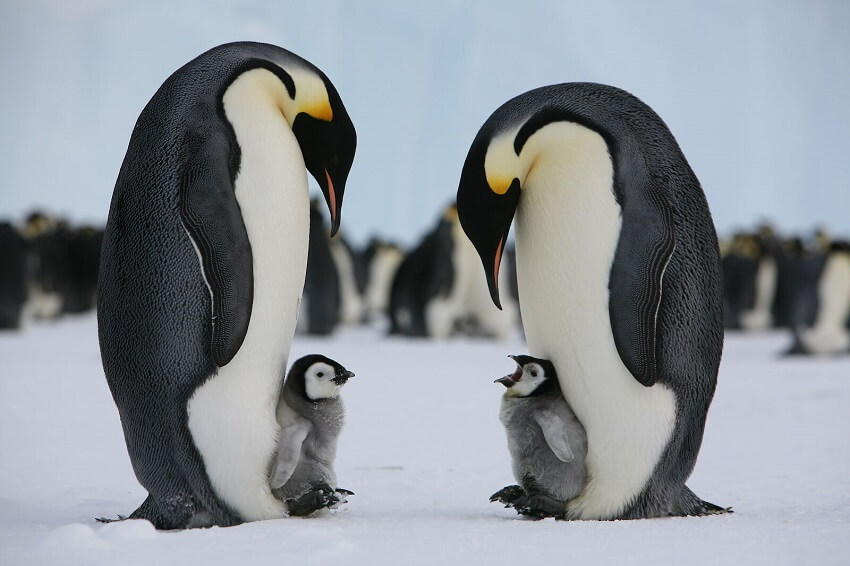
2. Penguin Species
The number of surviving species remains a subject of debate. Different texts list between 16 and 19 species. Some authors argue that the white-flippered penguin is a separate species (Eudyptula), although it is now generally considered a subspecies of the little penguin (e.g., Williams, 1995; Davis & Renner, 2003). Similarly, it is still unclear whether the royal penguin is simply a color morph of the macaroni penguin.
It is also quite appropriate to consider the northern population of the rockhopper penguin as a separate species (Davis & Renner, 2003). Although all living penguin species are native to the Southern Hemisphere, contrary to popular belief, they are not found exclusively in cold climates, such as Antarctica. In fact, only a few species truly live that far south. Three species live in tropical regions; one species lives as far north as the Galapagos Islands (the Galapagos penguin), and they sometimes even cross the equator while foraging.
The largest species is the Emperor Penguin (Aptenodytes forsteri): adults average about 1.1 m (3 ft 7 in) tall and weigh 35 kg (75 lb) or more. The smallest penguin species is the Little Penguin (also called the fairy penguin), which is only about 40 cm (16 in) tall and weighs 1 kg (2.2 lb). In general, larger penguins are better at retaining heat and therefore live in colder regions, while smaller penguins are mainly found in temperate or even tropical climates.
The majority of penguins eat krill, fish, squid, and other forms of marine life that they catch while swimming underwater. They spend about half their time on land and the other half in the oceans.
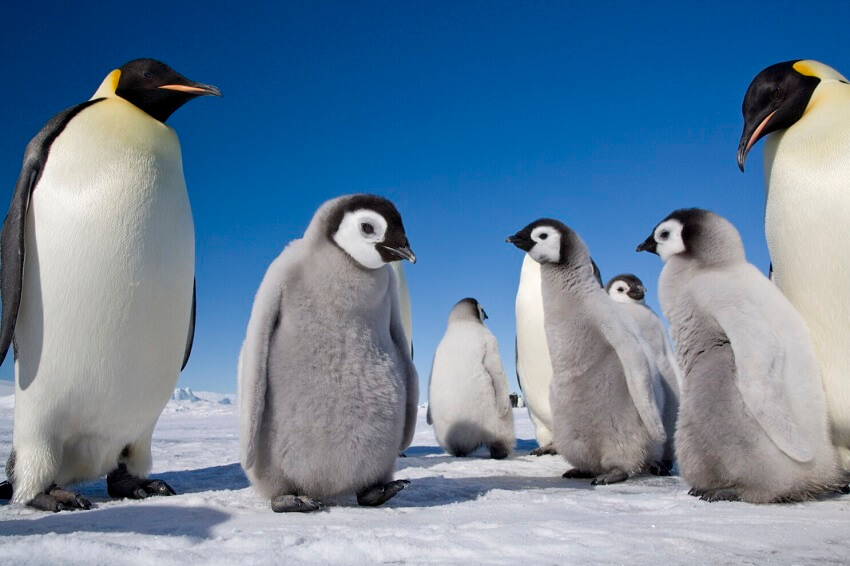
3. Penguin Characteristics
Here are some key characteristics of penguins:
- On average, adult penguins range from 40 cm to 1.1 m (16 inches to 3.6 feet) in height and weigh between 1 and 35 kg (2.2 and 77 lbs).
- Penguins have a small, streamlined head with a hard, pointed beak.
- Penguins have wings that function as flippers, making them professional divers. They can swim at speeds of up to 15 miles per hour.
- On land, penguins walk upright on two feet, but if the snow conditions are right, they can slide on their bellies.
- Their body shape is quite round, with a slightly curved back and a sagging belly.
- Under their shoulders, penguins have a pair of featherless wings that look similar to the fins of a dolphin.
- The lifespan of a penguin is between 15 and 20 years.
- Penguins are social animals that live in colonies.
- They spend half of their lives on land and the other half in the vast ocean.
- A penguin’s feathers are very thick and are a contrasting black and white.
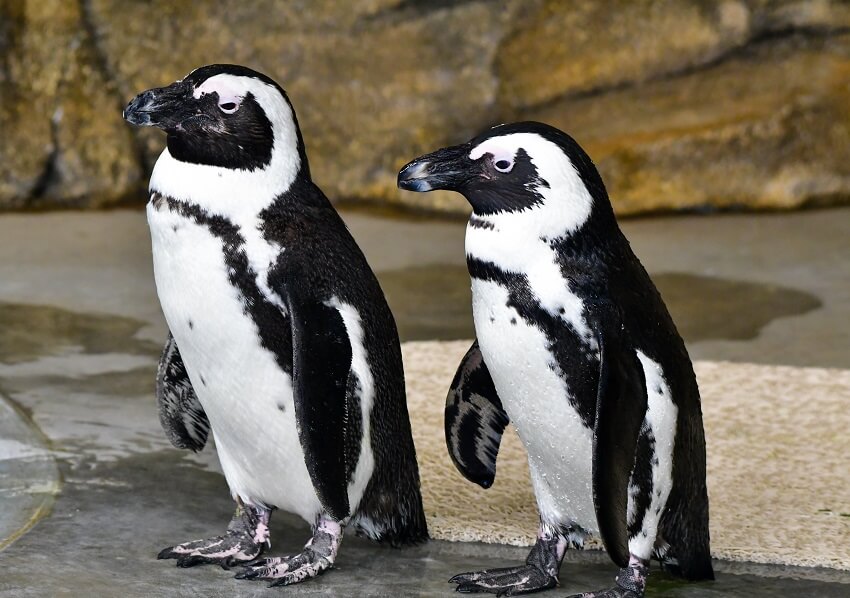
4. Penguin Distribution
Larger penguin species tend to live in colder places, where they can withstand the harsh weather, while smaller species live in temperate or even tropical climates. For this reason, penguins can even be found in South Africa, which is in a hot climate zone. Currently, 12 countries are home to very large penguin populations.
Ecuador, for example, has colonies of Humboldt and Galapagos penguins concentrated on the islands of the same name. Each animal is typically less than 50 cm (20 inches) tall, weighs 2.5 kg (5.5 lbs), and prefers cold water but can withstand hot weather.
Peru also has two types of penguins, including the king penguin, which has beautiful feathers similar to the emperor penguin with its black, white, and yellow coloring. Additionally, a number of other countries are fortunate enough to have populations of these adorable birds: Chile (10 species); Argentina (7); Uruguay (3); Brazil (1); Angola (1); Namibia (2); South Africa (4); Mozambique (1); Australia (11); and New Zealand (7).
Among New Zealand’s seven penguin species, the yellow-eyed penguin (hoiho) is an endemic and extremely rare species, with a population of only about 500 individuals (they have a unique biological feature, in that their entire eyes, including the pupils, are a captivating yellow color).
In contrast to the endangered yellow-eyed penguin, the macaroni penguin has a population of 24 million, with 260 colonies scattered across South America, Australia, and Marion Island. Chile alone has 18 million macaroni penguins (equal to the country’s population). Macaroni penguins can live for 12 years or more, while the little blue penguin only lives for 6 years and the Magellanic penguin for 30 years.
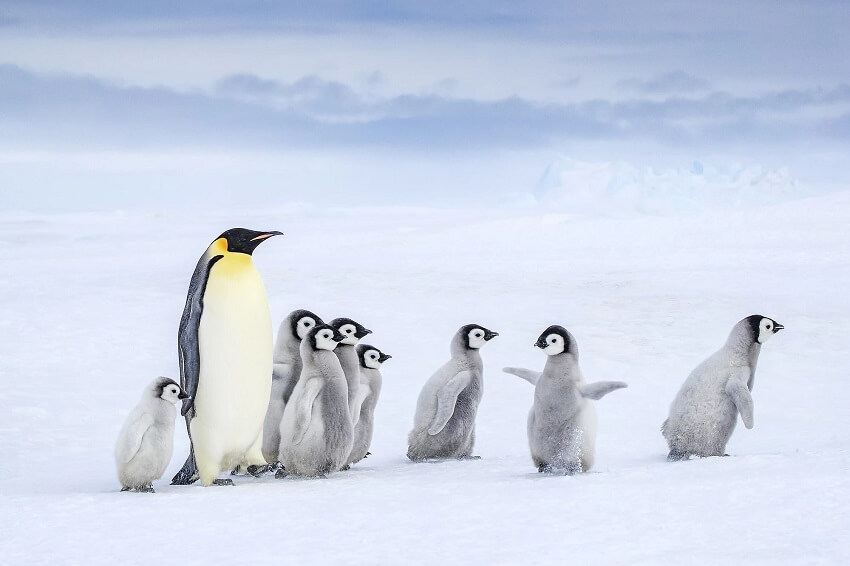
5. 10 Fun Facts About Penguins That Will Make You Love Them More
Penguins are not only adorable but also full of surprising traits. From their unique way of parenting to their incredible swimming skills, these 10 fun facts will reveal why penguins are among the most fascinating birds on Earth.
5.1. How Penguins Communicate
Penguins are highly social birds that live in colonies, always gathering in large flocks. Each colony can number in the tens of thousands. Despite such large and hard-to-control numbers, each pair of parent penguins can recognize and look after their chick through a special sense of hearing.
Within the penguin social community, they communicate and exchange information with each other through body language, using their heads and flippers. In particular, researchers are often surprised and amazed by the affection in their parent-child relationships. When a female loses her chick or her chick dies, she will try to “kidnap” a chick from another family to raise as her own. The most reasonable explanation is likely that the mothers cannot bear the pain of losing their child and must deceive themselves.
Depending on the penguin species, the lifespan of this bird is around 15–20 years. They spend up to 75% of their lives in the ocean. Penguins’ tear glands are quite unique; they can filter excess salt from their blood. The salt is secreted as a liquid through their nostrils. Therefore, they can drink seawater and live in this environment with ease.
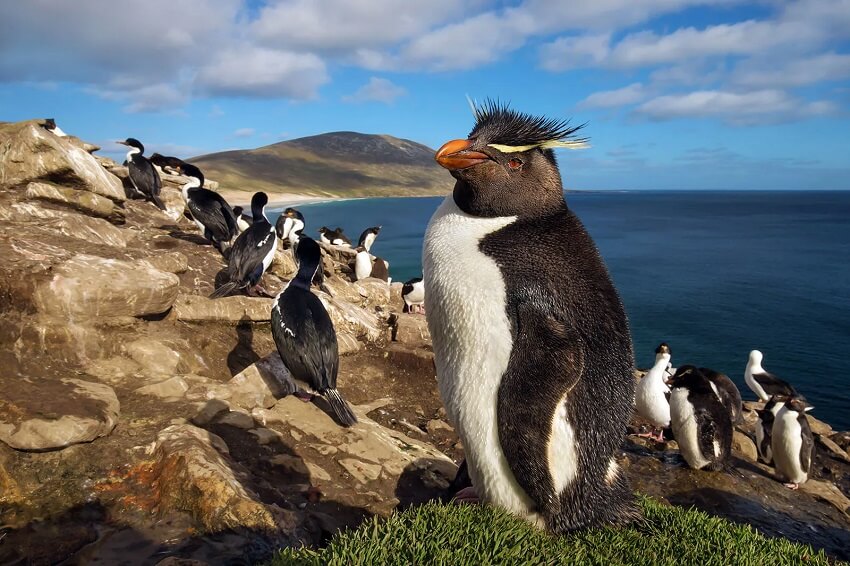
5.2. Penguins Are Incredibly Intelligent
The intelligence of penguins isn’t about solving problems like crows, says David Powell, Director of Research at the St. Louis Zoo. What’s important is whether that “intelligence” is actually helpful to the animals in their lives in the wild.
The cognitive abilities of penguins are not like how parrots learn to speak or crows solve problems. The Curator of Birds at the St. Louis Zoo, Anne Tieber, says she has been studying penguins for many years. They will cooperate with each other during hunting. Specifically, African penguins, which live around the southern tip of Africa, will work together to hunt. The individual penguins will spread out and herd the fish up to the surface, making them easier to catch. This coordinated hunting requires fast information processing, coordination between the movements of the penguins in the flock, and communication with each other, as well as an ability to predict the next movements of the fish school to make a decision. This method is three times more effective than other hunting methods.
Just like crows, which can remember human faces for many years, penguins have incredibly impressive memories. A pair of Adelie and Chinstrap penguins were fitted with tracking chips. Every year, they return to the same nesting site, which is also the breeding ground for thousands of other individuals. The explanation for this is a combination of navigation and an excellent memory.
Even at 10 months old, a King Penguin (the second largest species after the Emperor Penguin) can find its way back to a one-square-meter area within a large area of over 500 square meters. The King Penguins will use visual cues such as lakes, hills, and mountains. They particularly use the sounds of the area where they were born to return. A pair of King Penguins will recognize each other by their calls. They can find their mates even when hundreds of others are calling out in the same location.
5.3. Male Penguins Incubate the Eggs
Penguins lay eggs just like any other bird. Every year, during the breeding season, the male penguins will find a mate. Typically, penguins can lay about two eggs per breeding cycle. After their task is complete, the female penguins will lay the eggs. The penguin eggs will hatch after about 45 days of incubation. The parents will then raise the chicks for about 13 months before they leave.
Some penguin species may mate for life, while others only mate for a single season. In general, they produce a small brood, and both parents care for the young. In some species, the female lays fewer eggs (10-20), which she incubates for 65 days. After each incubation, the female loses 40-50% of her body mass. After the eggs hatch, the mother continues to warm the chicks.
The male penguins take on the role of incubating the eggs for about two months while the females go out to sea to forage. Throughout the incubation process, the father penguin will suspend his normal activities and focus solely on protecting the eggs. They use their stored body fat to sustain themselves. Typically, the male penguins will lose half of their body weight during this process. At the end of the two-month period, the male and female penguins will switch roles to ensure their own health.
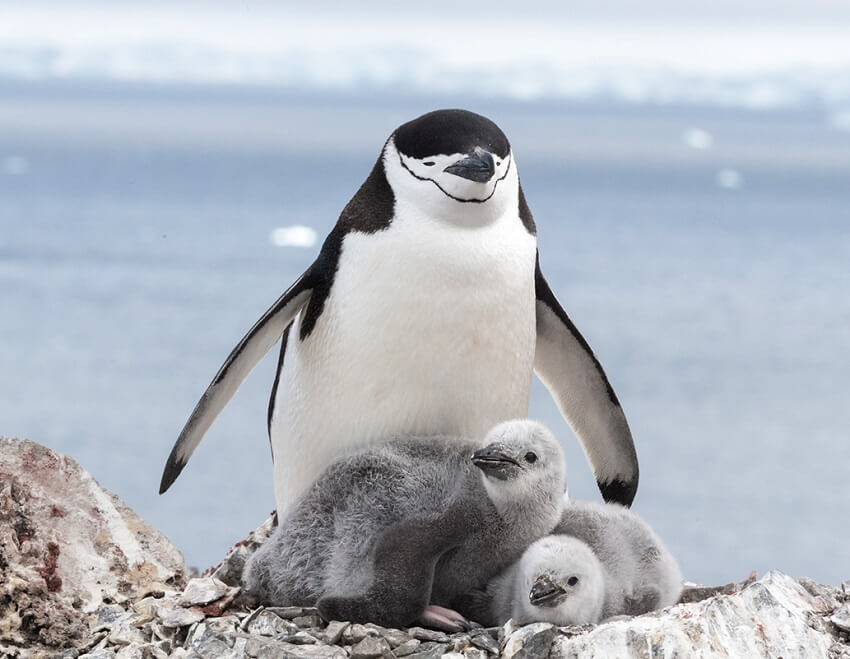
5.4. Unbeatable Swimming Ability
Penguins can’t fly, but they are excellent swimmers. They can swim at about 15 miles per hour, far surpassing Olympic gold medalist swimmer Michael Phelps’ speed of 4.7 miles per hour. They can dive underwater for a record of about 20 minutes. Typically, small penguins do not dive deep, and they hold their breath for only about one to two minutes to hunt for prey. However, the larger species can dive to a depth necessary for their survival, most notably the Emperor Penguin, which holds the diving record at 565m (1,854 ft).
For decades, the inability of penguins to fly was a mystery to scientists. However, a new study on the murre—a bird very similar to the penguin in its swimming and diving abilities, but which can still fly—has provided the final answer. Scientists from the University of Aberdeen in the UK found that no bird species can be good at both flying and swimming/diving. Even though they can’t fly, penguins are fantastic swimmers. They can dive as deep as 564 meters (1,850 ft) to catch fish, squid, and small crustaceans to eat.
The research team found that the murre bird uses less energy than most other birds when it dives. However, the energy it needs to move through the air is the highest ever recorded for a flying bird, and it is 31 times higher than when they are resting.
5.5. Hunting Camouflage Abilities
Penguins love to eat krill, fish, and squid. A penguin’s diet consists entirely of seafood. It’s no accident that a penguin has special feathers that are white on its belly and dark on its back. This is a way for penguins to camouflage themselves from prey. The black color helps them hide when they dive into the dark depths of the sea, while the white color helps them hide on icy patches or cold white snow.
Penguins have no external genitalia, so it is impossible to distinguish between a male and a female with the naked eye. Their gender can only be determined by checking their chromosomes. Interestingly, homosexuality also exists in penguin populations. At the Bremerhaven wildlife park in northern Germany, two male penguins incubated an egg together and behaved as a couple.
Penguins’ terrestrial predators vary, but they can include lizards, skunks, snakes, other birds, and weasels. Their aquatic predators are mainly killer whales, leopard seals, and sharks. While penguins are now protected, humans have been known to illegally hunt them for their oil and eggs.
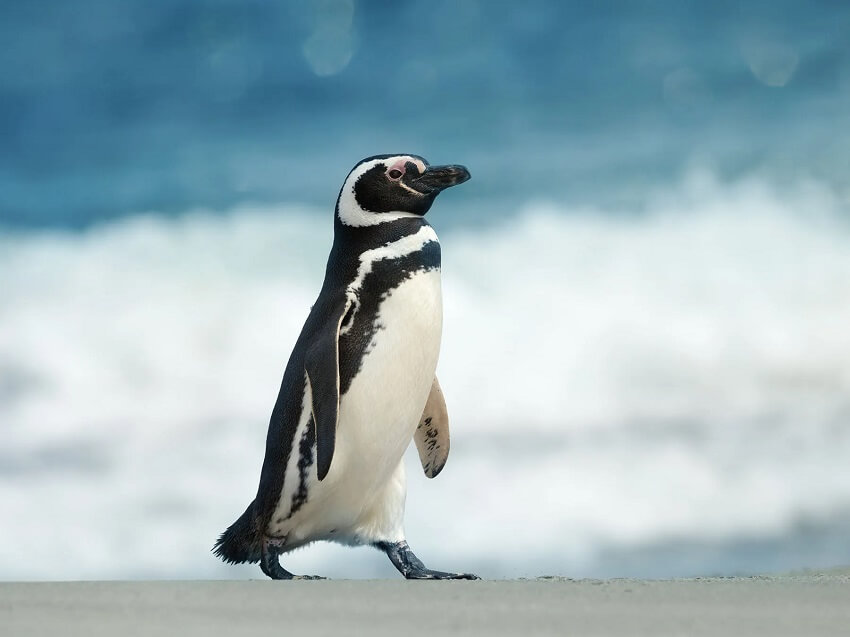
5.6. Why Don’t Penguins Live in the Arctic?
Penguins don’t live in the Arctic because they were born in the Antarctic. This is entirely a choice of nature. Fossil records show that they originated in the Antarctic. There, they are safe, have plenty of good food, and can live comfortably with the extremely cold temperatures.
Too many people (and documents) say that penguins live in the Antarctic to avoid becoming prey for polar bears and arctic foxes. However, the truth is not quite so simple. From a logical point of view, if penguins lived in the Arctic and then fled to the Antarctic, it would be an endless journey. Not to mention the countless difficulties and dangers that would lurk along the migration route.
Currently, scientists still have many questions about the evolutionary history of penguins. To date, only fossils from about 62 million years ago in New Zealand tell us that the Waimaru genus was the oldest penguin species. Their body structure was quite similar to that of modern penguins; their wings were very short, and they could not fly. The only difference is that the Waimaru back then didn’t actually live in the water or adapt to diving deep to catch prey.
In addition, their layer of fat and feathers would make it difficult for them to cross warm seas. With all these reasons, the most logical question we should ask is, “Why would penguins ever leave the Antarctic?”
5.7. A Penguin’s Ability to Withstand the Cold
Although they are not the only creatures that live in the Antarctic, penguins are endemic to the South Pole and are not found anywhere else. This animal can survive in such harsh weather conditions because its body is structured to adapt to the cold climate:
Penguins can withstand the cold because they have a special “feather coat” that is structured to keep them warm, block the wind, and shed water after foraging. Many people think that penguins don’t have feathers. However, in reality, penguins have the highest (densest) feather count of any other bird.
Another extremely important thing that helps them comfortably dive into freezing water is the thick layer of fat that Mother Nature has given them. You may not know this, but on average, a penguin has up to 30% of its body weight in fat.
The third reason is their social lifestyle. Penguins often live in large colonies of thousands, and the individuals in the colony can warm each other against the bone-chilling cold of the Antarctic.
Their ability to withstand the cold and their social lifestyle help penguins adapt to the harsh environment of the Antarctic. Some people may wonder what the difference between the Arctic and Antarctic is. Although the Arctic is not as cold, it is still an ideal habitat for penguins.
Perhaps the simplest reason is that they cannot fly to escape the polar bears and arctic foxes that prey on nesting birds during the summer. If penguins lived in the Arctic, they would be easy prey for these two carnivores. The second reason is that the Antarctic is simply too safe for them. There are no threats whatsoever, so they don’t have to worry about being hunted while nesting, and it is a very safe place for long-term settlement.
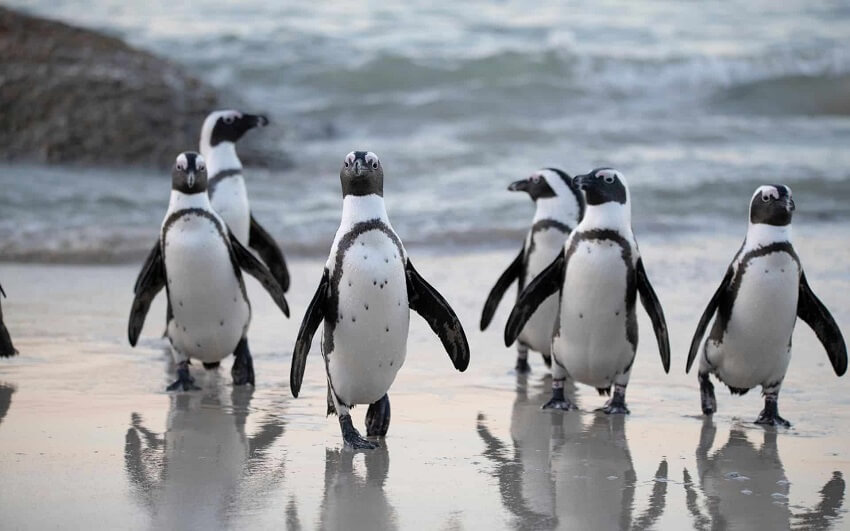
5.8. Why Don’t Penguin Eggs Freeze in Winter?
As one of the few creatures that live in Antarctica, penguins make many people wonder how they can keep their eggs from freezing when they breed in winter. The Emperor Penguin is the only penguin species that adopts a risky breeding strategy by laying its eggs in the winter. The females go out to forage while the males stay behind and incubate the eggs as the temperature gets colder.
The reason for breeding in the winter is very much related to their food source. When thousands of new penguin chicks hatch, they require tons of fish, squid, and krill for food. This food source is only available in the spring when the frozen areas melt. Incubating the eggs takes about four months, which means they need to lay them in the winter so the chicks can hatch in the spring.
To be able to incubate eggs in the winter, penguins have undergone certain evolutionary adaptations. They are covered in a thick layer of feathers that is a few centimeters thick, which helps keep them, their eggs, and their chicks warm.
Like many other penguins, the emperor penguin has a patch of bare skin on its belly called a “brood pouch.” They skillfully place the egg on their feet, press it against the bare skin, and cover it with their thick feathers to insulate the egg from the freezing world outside.
For a few weeks after hatching, the baby penguin spends all of its time in its parents’ “warming pouch.” Of course, the incubation process also depends on whether the parents can maintain ideal conditions. They are highly praised by scientists for their resilience in enduring the incubating position for months for the sake of their young. They also cleverly gather in colonies to ensure the most effective collective heat source.
5.9. Penguins Face the Threat of Extinction
Penguins, which are considered a “measure of the health of the ocean,” are facing many threats as global carbon emissions increase. This causes ocean waters to become warmer and more acidic, which affects coral reefs, the habitats of one-third of all marine life. Penguins are aquatic birds that swim through the ocean instead of flying. This species is particularly sensitive and susceptible to all impacts underwater.
They suffer from pollution and the consequences of overfishing, which limits their food supply. In particular, climate change is a major threat to this bird species.
According to the International Union for Conservation of Nature, two-thirds of the global penguin population is at risk of extinction, including eight species that live in Antarctica. Therefore, experts and organizations are looking for solutions to protect this rare animal. According to a plan, experts will create two large marine protected areas spanning nearly 3 million square kilometers around the frozen continent, in which one-third of the area will be completely off-limits to fishing. This will help move fishing and krill-fishing—a main part of the penguin’s diet—away from the penguins’ foraging grounds.
If this plan is approved by the 24 member countries and the European Union (EU), these protected areas will help protect penguins and other marine life.
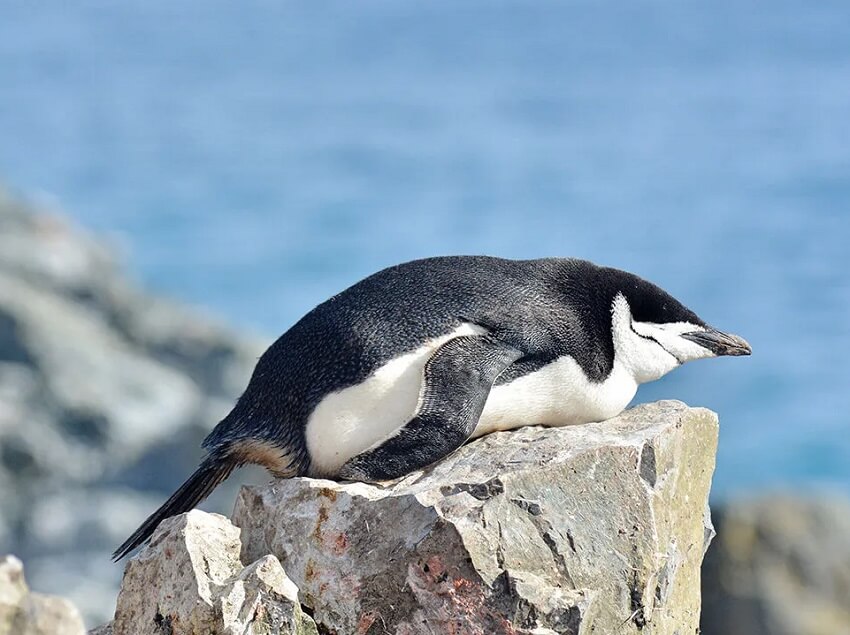
5.10. Penguins Appeared 20 Million Years Ago
According to a study published in the British journal Biology Letters on November 13, penguins appeared 20 million years ago and became diverse due to a drop in global temperatures, which opened up the possibility of living in the Antarctic. The research team, led by scientist Sankar Subramanian from Griffith University (Australia), sequenced the genetic markers from the genomes of 11 species of living penguins.
The experts compared these continuous markers to create a “molecular clock,” which helped shed light on how penguin species evolved based on typical changes in their DNA. With this comparison, scientists determined that the ancestor of penguins appeared 20.4 million years ago, much later than previous predictions of 41-51 million years ago.
Then, about 11-16 million years ago, penguins became diverse and evolved into the penguin species we know today. The research results coincide with the temperature drop in the Antarctic that began about 12 million years ago, which shows a relationship between climate change and penguin evolution.
6. Conclusion
Penguins are not only adorable but also resilient, intelligent, and full of surprises. Fun Facts About Penguins will help us love them more and appreciate the magical beauty of nature. Protecting penguins is also a way to help preserve the balance and beauty of our planet.

